Slovenian Economic Mirror
Related Files:
Slovenian Economic Mirror 3/2018
At the beginning of the year, activity in export-oriented sectors of the economy was slowed by developments in the international environment, while construction activity and private consumption continued to expand. The strong growth of Slovenia’s goods market shares in the EU and on the global market continued in the last quarter of 2017; the price competitiveness of Slovenian exporters deteriorated somewhat in the first quarter of this year.
Related Files:
- International environment
- Economic developments
- Labour market
- Prices
- Balance of payments
- Financial markets
- Public finance
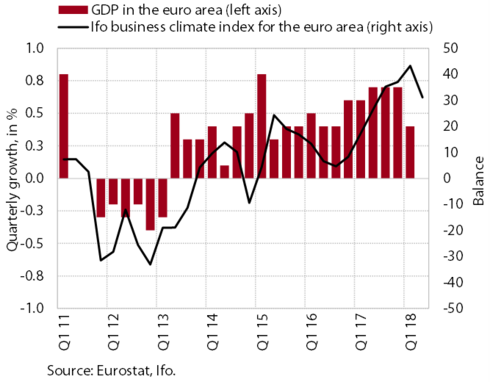
Economic growth in the euro area continued in the first quarter of 2018, but at a slower pace than in previous quarters. According to Eurostat’s preliminary flash estimate, quarter-on-quarter growth was the lowest in one and a half years, at 0.4%, seasonally adjusted; year-on-year growth was 2.5%. The slowdown of growth is also indicated by short-term indicators of economic activity in some of the largest euro area economies (particularly in manufacturing and retail trade ). In spite of less optimistic – yet still high – economic expectations (Ifo), the latest business confidence data (ESI, PMI) indicate no further deterioration in the second quarter.
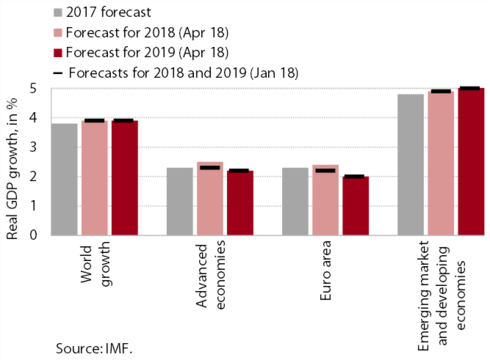
In its forecast in April, the IMF projected a continuation of strong global economic growth for this year and next. Economic growth should total 3.9% in both 2018 and 2019, which is similar to that last year. Growth in global trade is expected to continue. The main driver of growth will remain emerging-market and developing economies, particularly China, where economic growth is expected to remain stable (around 6.5%). A significant contribution to global GDP growth is also expected from advanced economies, particularly the US. According to the IMF, downside risks to GDP growth arise particularly from the uncertain trade policy of the US, a faster than expected increase in Fed interest rates, a continuation of uncertain financial market conditions, and escalated geopolitical tensions in the Middle East. Upside risks to the forecast are associated with higher confidence in the world economy and stronger investment.
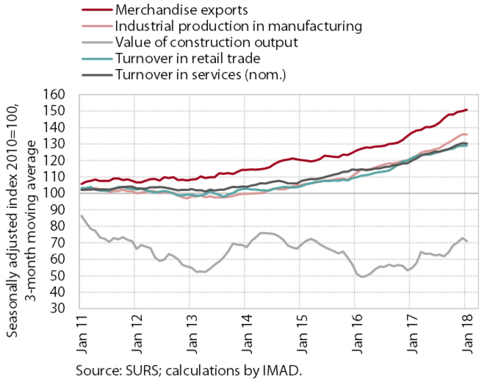
At the beginning of the year, activity in export-oriented sectors of the economy was slowed by developments in the international environment, while construction activity and private consumption continued to expand. Exports and manufacturing output in the first two months were affected by increased uncertainties in the international environment and recorded similar volumes to those at the end of last year. Turnover in market services also maintained the level achieved last year, while growth in the trade sector slowed. Activity in construction was affected by weather conditions, but the volume of construction was considerably higher than in the same period last year. Private consumption expanded further, reflecting favourable labour market trends, high consumer confidence and relatively strong growth in household loans. Confidence in the economy remained above the long-term average, despite a deterioration in recent months.

Real exports and imports of goods maintained their high levels at the beginning of the year. Affected by slowing growth in the international environment, export levels remained similar to those at the end of last year in the first two months of 2018. Year on year, exports were up 9.2%. The growth was broad-based, with exports of all key manufactured goods up year on year, the greatest contribution to growth coming from exports of vehicles. Imports also remained high, up 10.6% year on year in the first two months of 2018.

The growth of exports and imports of services remained high. In the first two months of the year, nominal exports were up 7.0% year on year, mainly as a consequence of higher exports of transport and technical, trade-related business services. Imports were up 5.2% in this period. In 2017 the most services were exported to Austria, Germany and Italy and imported from Croatia, Austria and Germany.

In the first two months of the year, production volume in manufacturing maintained a similarly high level as at the end of 2017. While there was a modest fall in production volume particularly in high-technology industries, production in other industry groups by technology intensity remained almost unchanged. Similar movements were also recorded for the EU. Year on year, manufacturing production in Slovenia was up by one-tenth and remains among the highest in the EU, where it averages 3.5%.

Activity in construction was up in the first two months of the year. Despite a decline in February in all three construction segments, construction activity remained relatively high, considering the unfavourable weather conditions; the prospects remain positive. The strengthening in the construction of buildings in recent years mainly reflects greater optimism in the private sector, while the higher value of civil-engineering works arises primarily from increased government investment.

Turnover in market services maintained its level at the beginning of the year. After a long period of strong growth, turnover fell in administrative and support service activities (particularly in employment services and travel-related services). In professional and technical activities, where it has been strengthening over the last few months under the impact of investment activity and favourable trends in construction, it rose further. In other activities, it remained more or less unchanged.
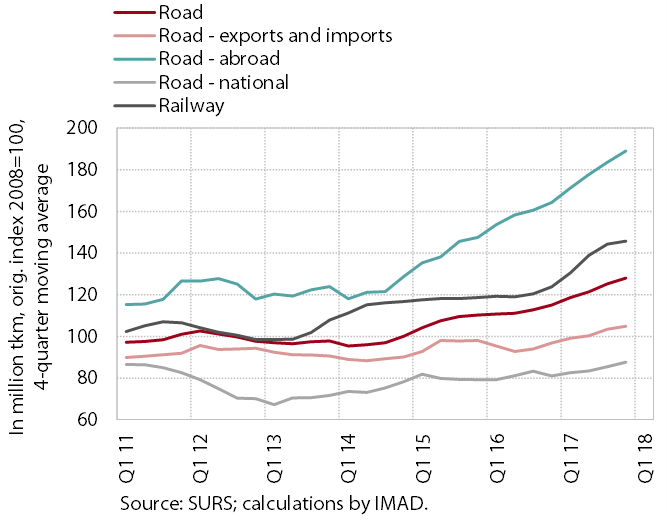
The strong growth in land freight transport eased in the last quarter of 2017. The slowdown was mainly attributable to a decline in the volume of transport by rail, though this rose strongly in the first half of the year and also made the greatest contribution to total growth. The quarterly growth in road freight transport performed by domestic hauliers slowed as well; owing to strong foreign demand, the strongest growth was again recorded for cross-trade transport. The higher demand for road transport services in Slovenia is increasingly being covered by hauliers from other countries, meaning that international trade in transport services increased further.
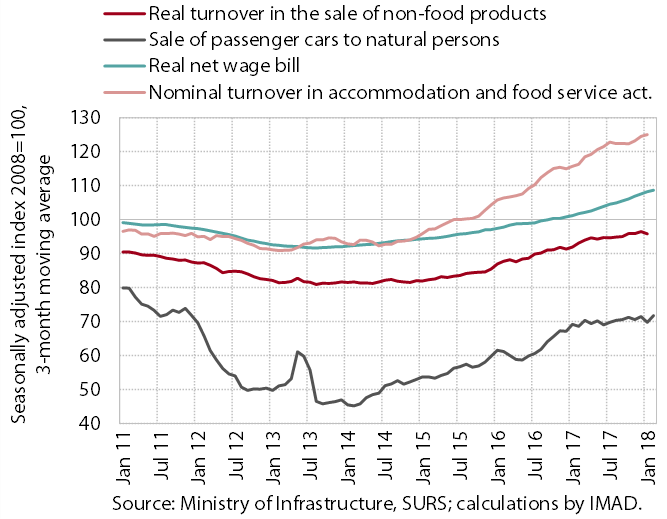
Household consumption increased further at the beginning of the year, reflecting the favourable labour market conditions and high consumer confidence. Owing to rising wages and employment, the net wage bill increased further; social transfers were also higher year on year. Higher income was reflected in higher household spending on semi-durable goods and services related to leisure activities at home and abroad. Purchases of durable goods also remained high.
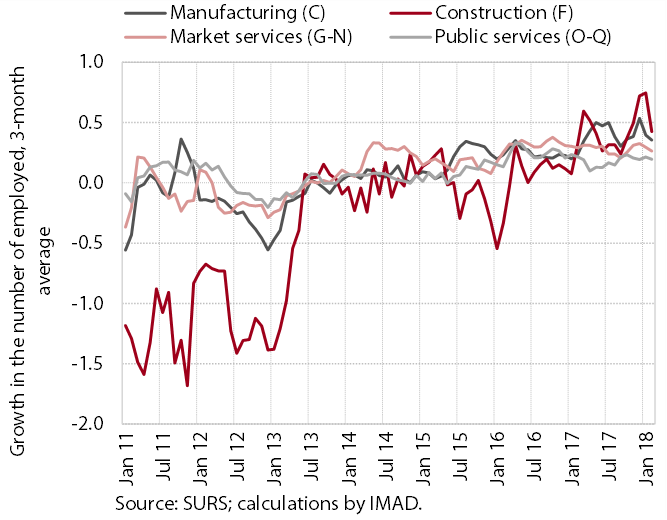
The number of persons employed continues to rise. At the beginning of this year, it reached the level last seen in mid-2008. In the first two months, it was up year on year in all private sector activities, particularly manufacturing, construction, trade and transport. The rise is mainly a consequence of strong growth in economic activity reflected in higher labour market participation and recruitment of foreign workers. Short-term expectations of enterprises about employment prospects remain high. In public service activities, meanwhile, year-on-year employment growth mainly stems from increased employment in the education (particularly primary education) and health sectors.
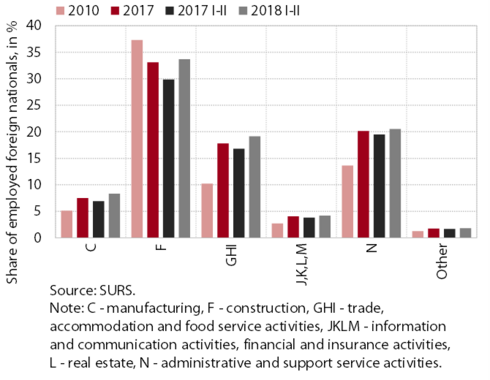
Employment of foreign workers is increasing. The number of employed foreigners started to rise more notably after 2014, particularly as a consequence of strong activity growth in sectors that typically stand out in terms of their shares of foreign workers (transportation and storage, accommodation and food service activities, manufacturing, and employment activities). In February, the number of employed foreign nationals was up 17.8% year on year (the number of employed Slovenian citizens was up 2.3%). The contribution of foreigners to growth in the total number of persons employed has risen to one-third.
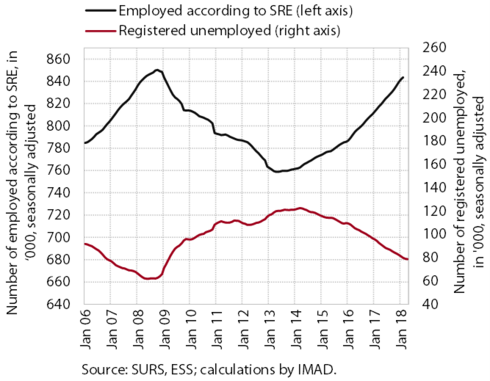
Amid strong hiring, the number of registered unemployed persons continues to decline. In the first four months, the inflow into unemployment dropped further year on year, largely because of fewer expiries of fixed-term employment contracts. There were also fewer first-time jobseekers, which is attributable both to the improvement in economic conditions and to smaller generations of young people finishing school. The outflow into employment was also somewhat more modest year on year, though still high. At the end of April, 78,555 persons were registered as unemployed, 13.8% fewer than in April 2017.
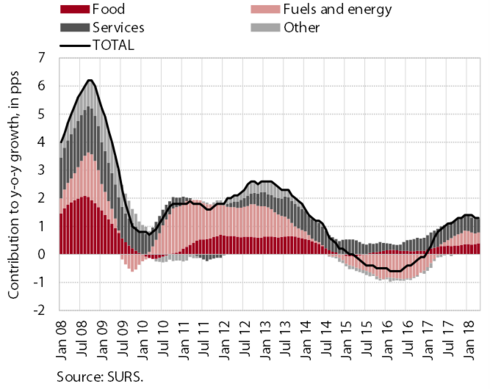
Consumer price growth remained moderate. Year-on-year growth in prices of services continues to exceed that in prices of goods. Particularly the contributions of prices in housing services, restaurants and hotels, and education were up year on year. Year-on-year growth in food prices strengthened again. The moderation of growth in the fuels and lubricants group reduced the contribution of transport. Prices of durable goods remained down year on year. The level of core inflation remained low and lower than the average for the euro area.
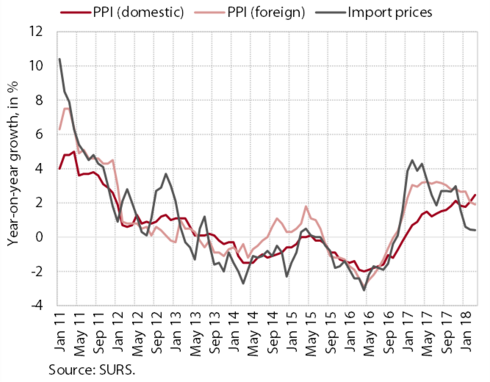
The year-on-year growth in import prices eased considerably at the beginning of the year; the moderate growth in domestic industrial producer prices continues. The slowing growth of import prices is attributable particularly to lower price rises in non-energy commodities, while the growth in energy prices picked up at the end of the first quarter. Reflecting favourable economic conditions, Slovenian producer prices saw stronger growth on the domestic market, where prices are rising across all industrial groups (at rates of more than 2%). Energy prices are increasing at the fastest pace (3.7%), according to our estimate mainly as a consequence of price movements in electricity, gas and steam supply, which are recording year-on-year growth following five years of decline. On foreign markets, the growth in Slovenian industrial producer prices again slowed slightly to reach a level comparable to that on the domestic market.
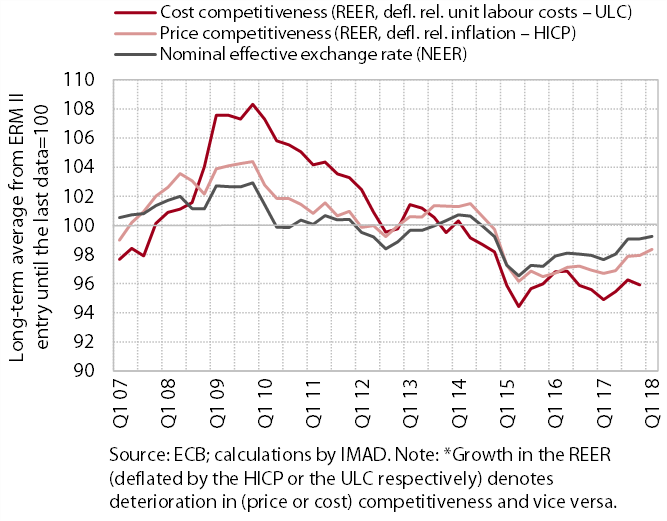
The slight deterioration of price competitiveness continued at the beginning of the year; cost competitiveness movements remained favourable for exporters at the end of last year. The further appreciation of the euro (and hence growth in the nominal effective exchange rate) put some negative pressure on Slovenia’s export competitiveness. The nominal effective exchange rate has been strengthening gradually since 2015, but it is still slightly lower than the long-term average. The movement of prices (measured by inflation) at the beginning of the year was similar to that in Slovenia’s trading partners, thus having – in contrast to the previous year – no visible impact on price competitiveness. Cost pressures (measured by unit labour costs), however, were lower than in our trading partners, which to a great extent mitigated the negative impact of the appreciation of the euro on the cost competitiveness of the economy.
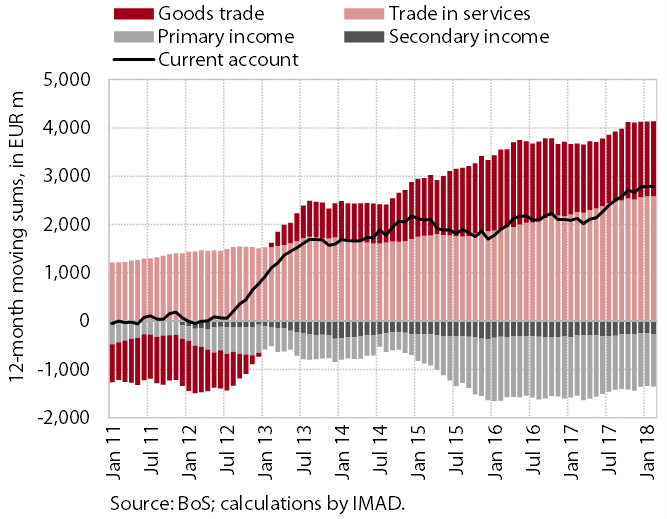
The surplus of the current account of the balance of payments remains high. The 12-month cumulative surplus for the period ending February 2018 amounted to EUR 2.8 billion or 6.0% of GDP. Its year-on-year increase was mainly due to the higher surpluses in international trade in goods and services, reflecting a favourable competitive position of Slovenian exporters, moderate growth in domestic consumption, and better terms of trade. The deficit in primary income was down for the most part because of lower external debt servicing costs, which is mainly related to lower interest payments. Owing to the deleveraging of commercial banks and investment in foreign securities, the private sector also recorded net interest receipts. The deficit in secondary income was lower because of the higher net positive current transfers of the government sector (receipts from the EU budget).
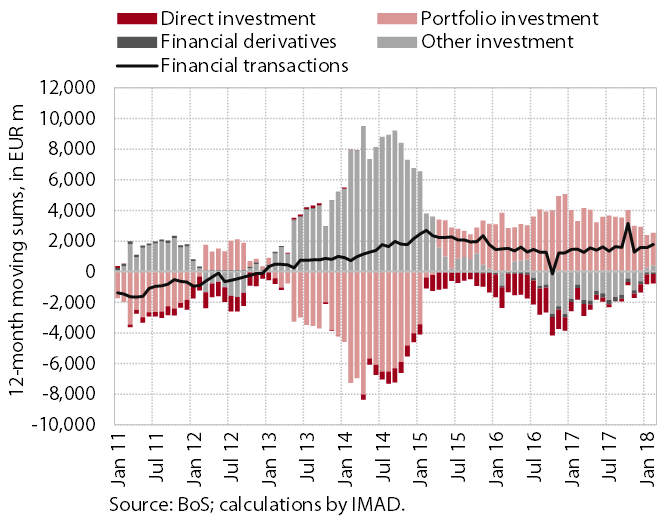
The net outflow in external financial transactions continues. External financial transactions recorded a net outflow of EUR 1.8 billion in the last 12 months, with the net outflow of the private sector and the BoS exceeding the net inflow of the government sector. The private sector was net financing the rest of the world by financial investment in foreign debt securities and by short-term trade credits. The government was withdrawing deposits from its accounts abroad, repaid a portion of foreign loans and borrowed money by issuing a bond. The decline in BoS deposits with non-residents was a consequence of low (or negative) interest rates on the money market and related investment decisions by the Bank.
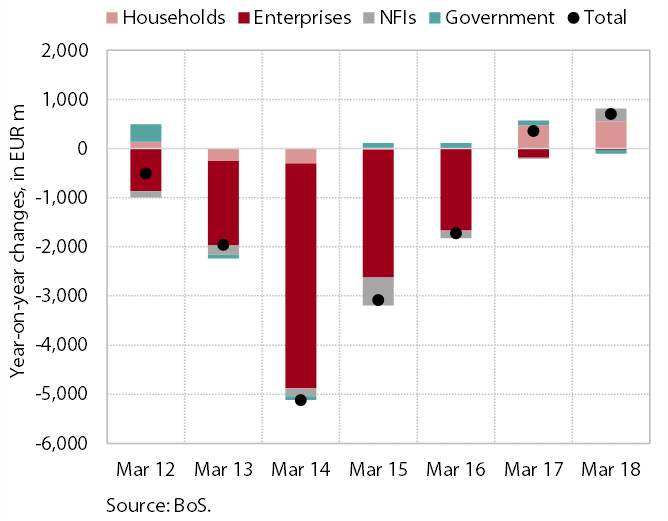
The growth in loans to domestic non-banking sectors eased slightly in the first quarter. The slowdown was largely a consequence of the lower volume of corporate loans. BLS data for the first quarter indicate no tightening of credit standards for corporate loans. Based on this, we assess that enterprises are to a greater extent relying on other sources of finance (for example own resources or crowdfunding platforms). Deposits by domestic non-financial sectors climbed to EUR 6.4 billion. The growth in household loans, which had eased somewhat early in the year, remains relatively strong. The volume of consumer loans, on the other hand, is rising faster. The gradual decline in non-performing loans continues.
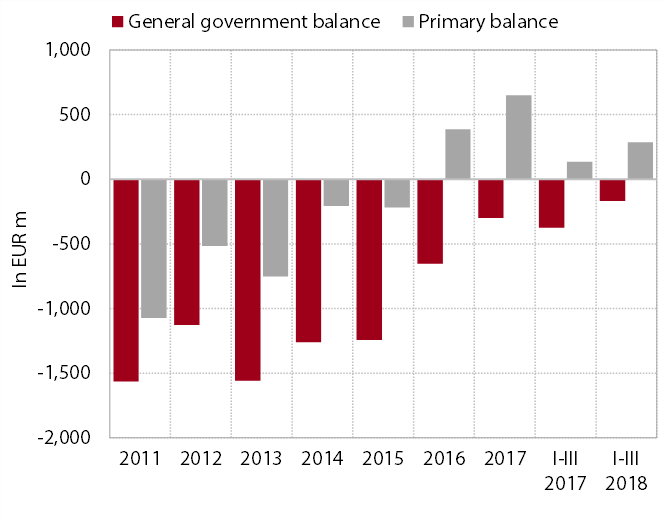
The general government deficit in the first quarter of 2018 (EUR 168 million) was more than 50 percent lower year on year. The continuation of the improvement in the general government balance – which should turn into a small surplus by the end of the year according to the adopted documents – was, similarly to last year, mainly related to favourable economic trends.
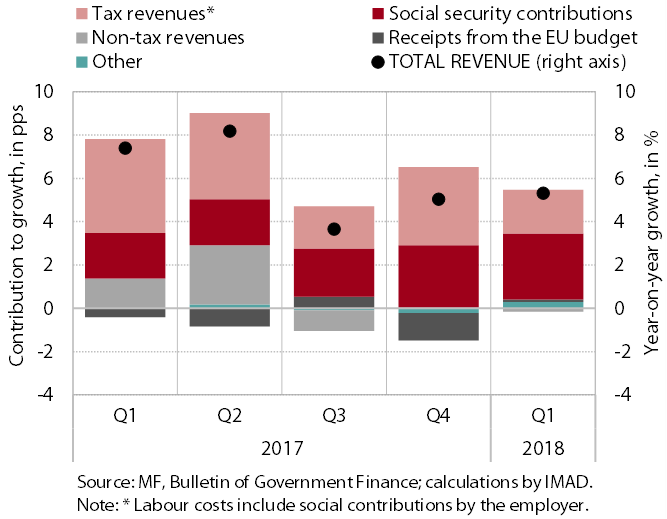
The year-on-year growth of general government revenue remained high in the first quarter (5.3%). This was a consequence of strong year-on-year growth in revenues from social contributions and tax inflows, which continued to reflect favourable labour market trends, improving business results and last year’s increase in the corporate income tax (CIT) rate. Year-on-year growth in VAT revenue was modest and lower than expected considering the favourable labour market trends; the inflows from excise duties were somewhat lower than in the same period last year. Non-tax revenues were also down year on year, this a consequence of the one-off inflow of interest in January 2017. Total receipts from the EU budget were similar to those in the same period of 2017; excluding the refunds of last year’s overpayments , they would have been lower year on year.
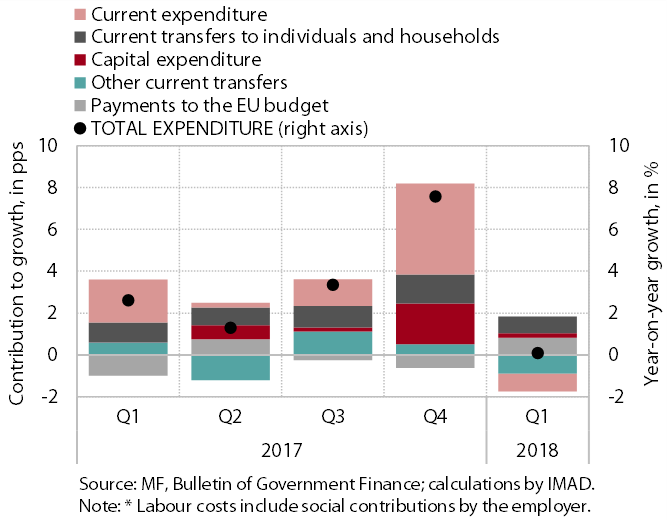
General government expenditure was unchanged year on year in the first quarter of 2018. Its growth was impeded by significantly lower interest payments year on year, lower transfers to social security funds (as a result of higher payments of contributions) and relatively low levels of more flexible expenditure categories (year on year lower expenditure on goods and services and subsidies). Compensation of employees, pensions and payments into the EU budget were all up year on year, as expected, as was investment expenditure, although this remains relatively low.
